
- Afrikaans
- Albanian
- Amharic
- Arabic
- Armenian
- Azerbaijani
- Basque
- Belarusian
- Bengali
- Bosnian
- Bulgarian
- Catalan
- Cebuano
- China
- Corsican
- Croatian
- Czech
- Danish
- Dutch
- English
- Esperanto
- Estonian
- Finnish
- French
- Frisian
- Galician
- Georgian
- German
- Greek
- Gujarati
- Haitian Creole
- hausa
- hawaiian
- Hebrew
- Hindi
- Miao
- Hungarian
- Icelandic
- igbo
- Indonesian
- irish
- Italian
- Japanese
- Javanese
- Kannada
- kazakh
- Khmer
- Rwandese
- Korean
- Kurdish
- Kyrgyz
- Lao
- Latin
- Latvian
- Lithuanian
- Luxembourgish
- Macedonian
- Malgashi
- Malay
- Malayalam
- Maltese
- Maori
- Marathi
- Mongolian
- Myanmar
- Nepali
- Norwegian
- Norwegian
- Occitan
- Pashto
- Persian
- Polish
- Portuguese
- Punjabi
- Romanian
- Russian
- Samoan
- Scottish Gaelic
- Serbian
- Sesotho
- Shona
- Sindhi
- Sinhala
- Slovak
- Slovenian
- Somali
- Spanish
- Sundanese
- Swahili
- Swedish
- Tagalog
- Tajik
- Tamil
- Tatar
- Telugu
- Thai
- Turkish
- Turkmen
- Ukrainian
- Urdu
- Uighur
- Uzbek
- Vietnamese
- Welsh
- Bantu
- Yiddish
- Yoruba
- Zulu
UAV
A UAV (Unmanned Aerial Vehicle), commonly known as a drone, is an aircraft that operates without a human pilot onboard. UAVs are widely used in industries such as defense, agriculture, logistics, and aerial photography, offering efficient, cost-effective, and innovative solutions for various applications.
Looking for high-performance UAVs for your applications?
Completely synergize resource taxing relationships via premier niche markets professionally.
Contact UsWhat Are The Different Types Of UAVs And Their Applications?
UAVs come in various types based on their size, range, and function, each designed for specific applications. The most common categories include fixed-wing UAVs, rotary-wing UAVs, hybrid UAVs, and high-altitude long-endurance (HALE) UAVs.
Fixed-wing UAVs resemble traditional airplanes and are known for their long flight endurance and high-speed capabilities. These UAVs are widely used for mapping, surveillance, and environmental monitoring, as they can cover large areas efficiently. They are commonly deployed in agriculture for crop monitoring, in disaster management for assessing affected regions, and in military operations for reconnaissance missions.
Rotary-wing UAVs, which include quadcopters and helicopters, offer greater maneuverability and the ability to hover in place. These UAVs are ideal for aerial photography, real-time surveillance, and delivery services. Due to their vertical takeoff and landing (VTOL) capabilities, they are widely used in urban areas where space is limited. Police and emergency response teams use rotary-wing UAVs for monitoring traffic, tracking suspects, and providing aerial support in rescue operations.
Hybrid UAVs combine the features of both fixed-wing and rotary-wing UAVs, allowing them to take off vertically and transition into forward flight for extended range and efficiency. These UAVs are used in applications where flexibility is required, such as cargo transport and long-range surveillance.
High-altitude long-endurance (HALE) UAVs are designed for extended missions at high altitudes. These UAVs are primarily used for military intelligence, weather monitoring, and scientific research. Equipped with advanced sensors, they can remain airborne for days or even weeks, providing real-time data collection over vast areas.
With continuous advancements in UAV technology, their applications are expanding rapidly, from autonomous drone deliveries to advanced military operations. The integration of AI, improved battery life, and enhanced communication systems will further enhance UAV capabilities in the future.
Types of UAVs and Their Applications
-
 Fixed-Wing UAVsDesigned for long-range missions, used in mapping, surveillance, and agricultural monitoring.
Fixed-Wing UAVsDesigned for long-range missions, used in mapping, surveillance, and agricultural monitoring. -
 Rotary-Wing UAVsIncludes quadcopters and helicopters, ideal for aerial photography, law enforcement, and deliveries.
Rotary-Wing UAVsIncludes quadcopters and helicopters, ideal for aerial photography, law enforcement, and deliveries. -
 Hybrid UAVsCombines fixed-wing and rotary-wing capabilities, offering flexible use in transport and reconnaissance.
Hybrid UAVsCombines fixed-wing and rotary-wing capabilities, offering flexible use in transport and reconnaissance. -
 HALE UAVsHigh-altitude drones used for weather monitoring, military intelligence, and extended surveillance missions.
HALE UAVsHigh-altitude drones used for weather monitoring, military intelligence, and extended surveillance missions.











